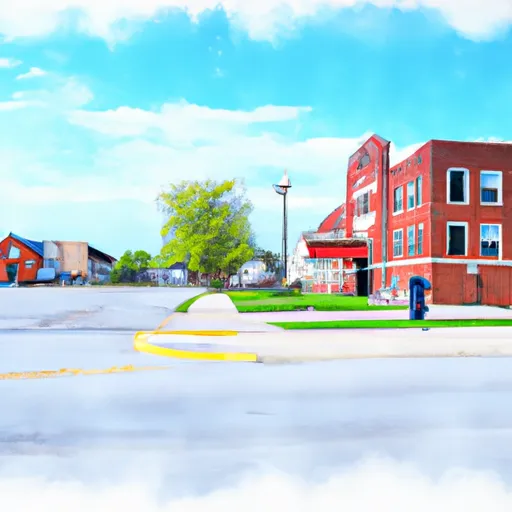-
 Snoflo Premium
Snoflo Premium
Get unlimited access to all our content
With no Ad interruptions! - Start Your Free Trial Login with existing account
Maunie
Eden Index
Climate
8.2
•
Recreation
2.8
•
Community
•
Safeguard
4.3/10

Maunie, Illinois is a small village located in the southern part of the state. It experiences a humid subtropical climate with hot summers and mild winters. Average temperatures range from the upper 80s in summer to the mid-30s in winter. Precipitation is evenly distributed throughout the year, with an average annual rainfall of around 45 inches.
The village is surrounded by diverse hydrology constituents, including the nearby Wabash River and several smaller lakes and ponds. These water bodies provide excellent opportunities for fishing, boating, and other water-based activities. The Wabash River, in particular, is known for its abundant catfish, bass, and crappie populations.
Outdoor recreation enthusiasts will find plenty of opportunities in Maunie and its surroundings. The village is surrounded by picturesque forests and natural areas, making it an ideal location for hiking, camping, and wildlife observation. Hunting is also popular in the area, with deer, turkey, and waterfowl being the primary game species.
Overall, Maunie, Illinois offers a pleasant climate, diverse hydrology constituents, and a range of outdoor recreation opportunities for visitors and residents alike.
What is the Eden Index?
The Snoflo Eden Index serves as a comprehensive rating system for regions, evaluating their desirability through a holistic assessment of climate health, outdoor recreation opportunities, and natural disaster risk, acknowledging the profound impact of these factors on livability and well-being.
Climate Health Indicator (CHI): 8.2
Maunie receives approximately
1169mm of rain per year,
with humidity levels near 83%
and air temperatures averaging around
14°C.
Maunie has a plant hardyness factor of
6, meaning
plants and agriculture in this region thrive during a short period during spring and early summer. Most
plants will die off during the colder winter months.
By considering the ideal temperature range, reliable water supplies, clean air, and stable seasonal rain or snowpacks, the Climate Health Indicator (CHI) underscores the significance of a healthy climate as the foundation for quality living.
A healthy climate is paramount for ensuring a high quality of life and livability in a region, fostering both physical well-being and environmental harmony. This can be characterized by ideal temperatures, reliable access to water supplies, clean air, and consistent seasonal rain or snowpacks.
Weather Forecast
Streamflow Conditions
Wabash
Area Rivers
Wabash
Snowpack Depths
Wabash
Reservoir Storage Capacity
Wabash
Groundwater Levels
Recreational Opportunity Index (ROI): 2.8
The Recreational Opportunity Index (ROI) recognizes the value of outdoor recreational options, such as parks, hiking trails, camping sites, and fishing spots, while acknowledging that climate plays a pivotal role in ensuring the comfort and consistency of these experiences.
Access to outdoor recreational opportunities, encompassing activities such as parks, hiking, camping, and fishing, is crucial for overall well-being, and the climate plays a pivotal role in enabling and enhancing these experiences, ensuring that individuals can engage in nature-based activities comfortably and consistently.
Camping Areas
| Campground | Campsites | Reservations | Toilets | Showers | Elevation |
|---|---|---|---|---|---|
| Runaway Branch | None | 87 ft | |||
| Forkland/McConnico Creek | 42 | 150 ft | |||
| Beech Bend | None | 373 ft | |||
| Belmont Park | None | 87 ft | |||
| Sumter Rec Area | None | 128 ft | |||
| Foscue | 54 | 95 ft | |||
| Lenoir Landing - Coffeeville Lake | None | 52 ft | |||
| Bladon Springs State Park | 10 | 193 ft | |||
| Lock 7 | None | 112 ft | |||
| Service | 32 | 123 ft |
Nearby Ski Areas
Catastrophe Safeguard Index (CSI):
The Catastrophe Safeguard Index (CSI) recognizes that natural disaster risk, encompassing floods, fires, hurricanes, and tornadoes, can drastically affect safety and the overall appeal of an area.
The level of natural disaster risk in a region significantly affects safety and the overall livability, with climate change amplifying these risks by potentially increasing the frequency and intensity of events like floods, fires, hurricanes, and tornadoes, thereby posing substantial challenges to community resilience and well-being.
Community Resilience Indicator (CRI):
The Community Resilience Indicator (CRI) recognizes that education, healthcare, and socioeconomics are crucial to the well-being of a region. The CRI acknowledges the profound impact of these elements on residents' overall quality of life. By evaluating educational resources, healthcare accessibility, and economic inclusivity, the index captures the essential aspects that contribute to a thriving community, fostering resident satisfaction, equity, and social cohesion.

